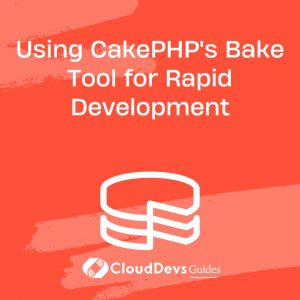Using CakePHP’s Bake Tool for Rapid Development
In today’s fast-paced development environment, efficiency and productivity are paramount. Developers often find themselves repeating mundane and time-consuming tasks that hinder their progress. Fortunately, frameworks like CakePHP provide powerful tools to streamline the development process. One such tool is the Bake Tool, which offers rapid development capabilities by automating code generation and providing a solid foundation for building robust applications. In this blog post, we’ll explore the benefits of using CakePHP’s Bake Tool and demonstrate how it can help you save time and effort.
1. Understanding CakePHP’s Bake Tool
CakePHP’s Bake Tool is a command-line utility that automates the process of creating files and generating code templates for your CakePHP applications. It eliminates the need to write boilerplate code manually, allowing you to focus on the unique aspects of your project. The Bake Tool leverages the power of CakePHP’s conventions and inflection system to generate code that adheres to best practices and maintains consistency throughout your application.
2. Getting Started with the Bake Tool
To start using the Bake Tool, ensure that you have CakePHP installed on your system. Once you have a CakePHP project set up, open a terminal or command prompt and navigate to the project’s root directory. From there, you can access the Bake Tool by running the following command:
bash bin/cake bake
3. Generating Code with Bake
3.1 Creating Database Tables and Models
One of the most time-consuming tasks in web development is setting up database tables and creating corresponding models. With the Bake Tool, this process becomes a breeze. Simply run the following command to generate a table and model based on your database configuration:
bash bin/cake bake model <table_name>
For example, to create a “users” table and model, you would run:
bash bin/cake bake model users
The Bake Tool analyzes your database schema and generates model classes with predefined validation rules, associations, and behaviors based on the table structure. This saves you valuable time, ensuring that your models are correctly set up without manual intervention.
3.2 Generating Controllers and Views
Creating controllers and views is another repetitive task that can be automated with the Bake Tool. To generate a controller for a specific model, run the following command:
bash bin/cake bake controller <model_name>
For example, to generate a “UsersController” for the “users” model, use the following command:
bash bin/cake bake controller Users
The Bake Tool will create a controller file with pre-built CRUD (Create, Read, Update, Delete) actions and corresponding views. These views are generated with basic HTML structure, ready for customization to fit your application’s design.
3.3 Scaffolding
Scaffolding is a powerful feature provided by the Bake Tool, which allows you to generate a fully functional CRUD interface for your models without writing a single line of code. To scaffold a model, run the following command:
bash bin/cake bake scaffold <model_name>
For instance, to scaffold the “users” model, execute:
bash bin/cake bake scaffold users
This generates a complete set of controllers, views, and templates that provide a basic interface for creating, reading, updating, and deleting records from the associated model’s table. Scaffolding is particularly useful during the early stages of development when you need a quick way to interact with your data.
4. Customizing Bake Templates
While the Bake Tool provides sensible defaults for code generation, you can customize the templates it uses to suit your specific needs. By modifying the templates, you can control the generated code’s structure, styling, and even incorporate your own conventions. The templates are located in the “src/Template/Bake” directory of your CakePHP project.
For example, if you want to customize the view templates, navigate to the “src/Template/Bake/Element” directory and modify the corresponding files. By tailoring the templates to match your project’s requirements, you can maintain consistency across generated code and enhance code quality.
Conclusion
CakePHP’s Bake Tool is a valuable asset for developers seeking rapid application development. By automating the generation of code templates, the Bake Tool saves considerable time and effort, allowing you to focus on the core aspects of your project. It streamlines the process of creating database tables, models, controllers, and views, while maintaining consistency and adhering to CakePHP conventions. Moreover, the ability to customize templates empowers you to shape the generated code to suit your project’s specific needs. Incorporating CakePHP’s Bake Tool into your development workflow will undoubtedly boost your productivity and help you deliver high-quality applications efficiently.
Table of Contents








